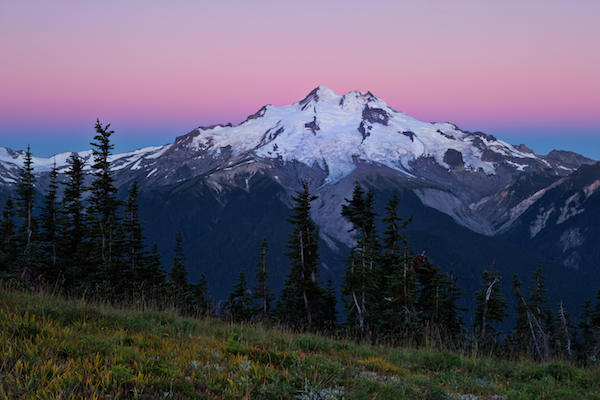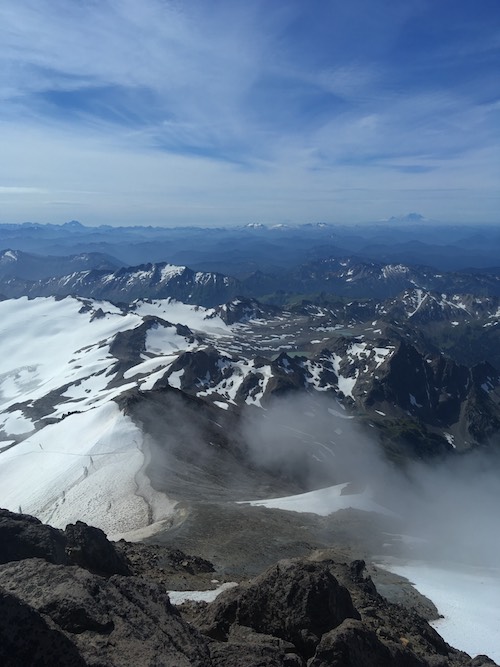Glacier Peak Climb and Skills Clinic Overview Glacier Peak is famous for its location, buried deep in the heart of the Cascades. It is the most remote of the Cascade volcanoes, and indeed, it was the last of them to be climbed. The first team to make the summit was a U.S. Geological Survey Team in 1897. The team followed the same route as AAI Teams do today, they climbed the Disappointment Peak Cleaver.
But it is unlikely that the geological team had the same goals as those we have today. AAI's approach to Glacier Peak is one of education. This mountain is one of several peaks where we offer "skills and climb" programs. As such, the objective is not only to make the summit of the mountain, but also to learn some baseline mountaineering skills along the way.
This program was designed to be an intensive introduction to the art of backcountry mountaineering while also providing the opportunity to climb one of Washington's classic alpine volcanoes. The primary goal is for competent backpackers to make the jump up to become competent glacier mountaineers. The secondary goal is to ascend a moderate glaciated route up to a pleasant summit.
Glacier Peak is a beautiful mountain. William D. Lyman, a late nineteenth century historian and mountaineer, incitefully wrote about the mountain's ellegance above the landscape. "It can be seen in all its snowy vastness, ten thousand feet high, and bearing upon its broad shoulders miles and miles of rivers of ice, the most beautiful and significant of all the poems of nature."
Perhaps the best way to recite this "poem of nature" is to enjoy an educational climb on this spectacular mountain.
Glacier Peak from the East. The left-hand shaded glacier in this photo is the Chocolate Glacier. The large rock face in the center is known as North Guardian Rock. The glacier below the rock is North Guardian Glacier. And the right-hand shaded ridge is Frostbite Ridge, a common objective on private programs. John Scurlock
Glacier Peak Climb and Skills Clinic Curriculum Principal Goals of the Glacier Peak Skills and Climb:
To make mountain enthusiasts with little or no previous climbing experience capable of gaining safe access to trailless, wilderness alpine areas.
To make them proficient in all basic alpine mountaineering skills for rock, snow, and ice.
To help them understand and protect the fragile alpine environment. We work hard to instill in participants an appreciation of both specific concepts and specific techniques that will allow them to travel through and climb in alpine areas skillfully, confidently, and without leaving a trace.
Upon completion of the program, each participant should be qualified as a technically competent rope team member capable of making alpine mountaineering ascents on routes of intermediate difficulty.
This course is intended to serve as an intensive introduction to off-trail alpine travel, and to fundamental glacier mountaineering skills.
Climbing and Mountain Skills:
Selection and use of personal equipment
Selection and use of ropes, knots, and harnesses
Selection and use of snow, & ice anchors for belays & intermediate protection
Belaying techniques for snow, and ice
Principles of glacier travel & route finding
Self-arrest; rappelling, & prusiking
The concept and application of the self-belay
Individual & team crevasse rescue techniques
Leave No Trace travel, camping, and climbing
An introduction to alpine ecology
Map, compass, altimeter and GPS use: reading, intersection, and triangulation
Evaluation and prediction of mountain weather patterns
Introduction to avalanche hazard evaluation
The view down from Glacier Gap. Sam Boyce
Glacier Peak Climb and Skills Clinic Itinerary Day 1:
On the first day of the program, the team will meet at 7am at the AAI headquarters in Bellingham, Washington for a comprehensive equipment check. Following that, the team will drive to North Fork Sauk Trail Trailhead (2,100'), approximately two hours away.
The team will then hike the North Fork Sauk Trail (5.2 miles) to the Mackinaw Shelter (3000'). Once we are there, we will cover some basic knots and hitches and discuss the use of the climbing harnesses and ropes.
Day 2:
On the second day of the program, the team will get up early and hike 8.2 miles to Glacier Gap Camp at 7,300-feet. This will be a big day with 4,300-feet of elevation gain. The entire focus of this second day will be to get to the Glacier Gap Camp.
Day 3:
On the third day of the program, we will focus on snow school skills. This includes: effective movement over snow, the 9 principle ice axe positions, snow anchors, belay techniques, and roping up for glacier travel.
Day 4:
The primary focus of the fourth day of this program will be on crevasse rescue systems. The team will discuss mechanical advantage, and then build hauling systems. Crevasse rescue systems to be covered are the 3:1 and 6:1 direct hauls, and the 2:1 team drop C rescue system.
Day 5:
On Day 5, the team will make a summit bid and then start back toward the trailhead. We will climb 3,200-feet over 2.8 miles to the summit (10,525') and then return to the Glacier Gap Camp.
From camp, we will travel approximately 4.5 miles and lose 1700-feet to camp at the White Pass Campground (5,800').
Day 6:
On the final day of the program, we will hike 9 miles back out to the trailhead and then return to the AAI headquarters in Bellingham.
Glacier Peak Climb and Skills Clinic Dates and Details
June 10 - June 15, 2024
June 24 - June 29, 2024
Aug 19 - Aug 24, 2024
It is also possible to set-up this as a private program. Please inquire with the Cascade Programs Coordinator for more information.
It is also possible to set-up private programs for the Frostbite Ridge, a more advanced level route.
Variations throughout the season... While all of these courses run during what we consider the "summer season," there is a large amount of variability in the weather and conditions that a climber could experience throughout this time. We recognize that most of our participants sign up for our programs weeks or months in advance, and although we can never be fully certain of what we'll encounter in the mountains that far out, you can click here for a description of what can typically be expected throughout the summer as well as a guide on picking the timeframe that is best for you
Prerequisites:
Participants should have backpacking experience and an excellent level of physical fitness. Glacier Peak is a true backcountry peak, and we will need to cover a lot of terrain in order to get into position to study mountaineering skills and to make a summit attempt.
If you don't have backpacking experience, it is possible to take AAI's 2-day Backpacking and Wilderness Skills program prior to the start of the Glacier Peak Skills and Climb.
Note:
The content of this program is very similar to that of an Alpinism I: Introduction to Mountaineering program. The difference between this program and the Alpinism I program is that this program does not have an introduction to rock climbing day built in and does not cover steep ice climbing. This is the perfect program for an individual who is looking to transition from backpacking to introductory level mountaineering.
Those who have completed an Alpinism I course and are not interested in rock climbing, may find this course to be an excellent follow-up and review.
Glacier Peak Climb and Skills Clinic Related Courses
Program Finder
By Location
United States - Alaska
United States - Washington
United States - California
United States - Nevada
United States - Colorado
United States - Utah
Canada - British Columbia
South America - Argentina
South America - Bolivia
South America - Ecuador
South America - Patagonia
South America - Peru
Europe - Alps and Caucasus
Asia - Nepal and Tibet
Asia - Laos, Thailand, & Vietnam
Asia - China
Asia - Japan
Africa - Tanzania
Pacific and Antarctica
By Program Type
Instructional Courses
Group Summit Climbs
Expeditions
Skills Expeditions
Private Guided Programs
Treks, Tours, & Backpacking
Corporate Outings & Services
Government & Military
By Activity
Rock Climbing
Ice Climbing
Alpine Climbing
High-Altitude Climbing
Trekking and Backpacking
Skiing & Snowboarding
Guide Training & Rescue
Avalanche Training
Departure Month
Difficulty Level
Beginner
Moderate
Intermediate
Advanced
Very Advanced
x



